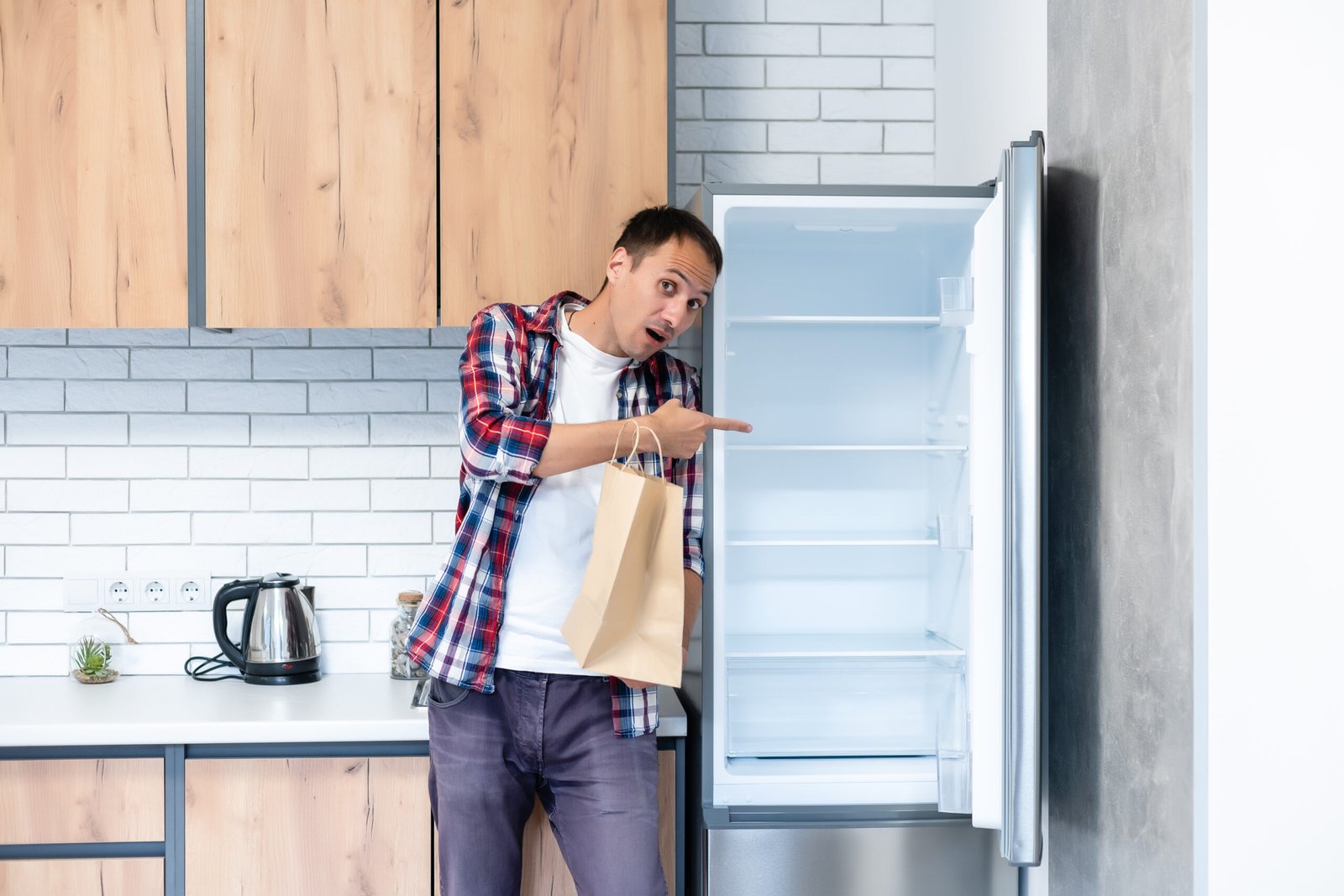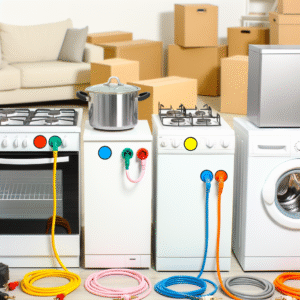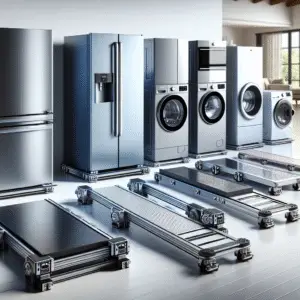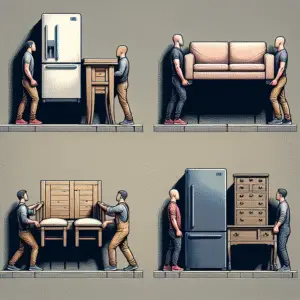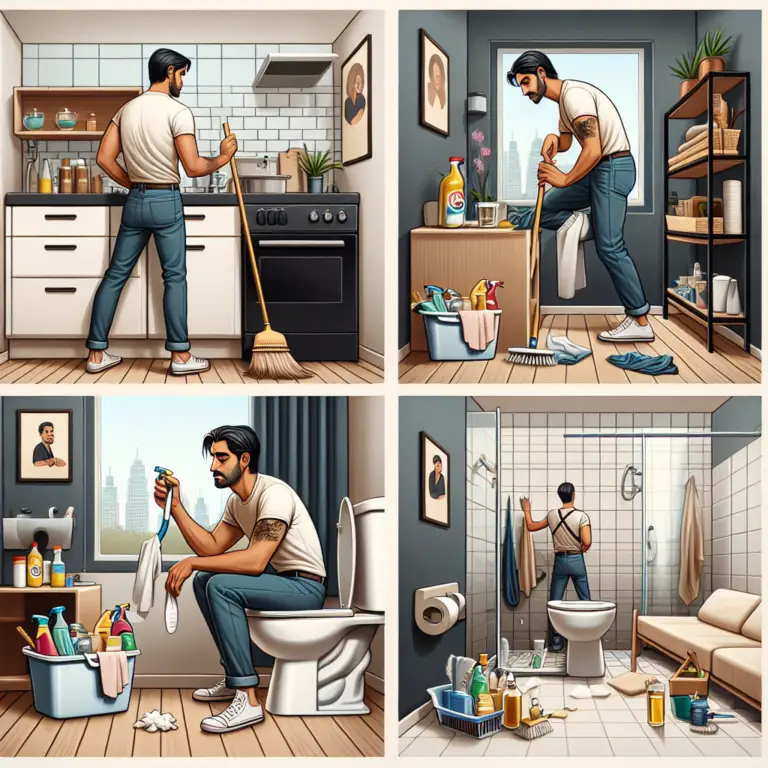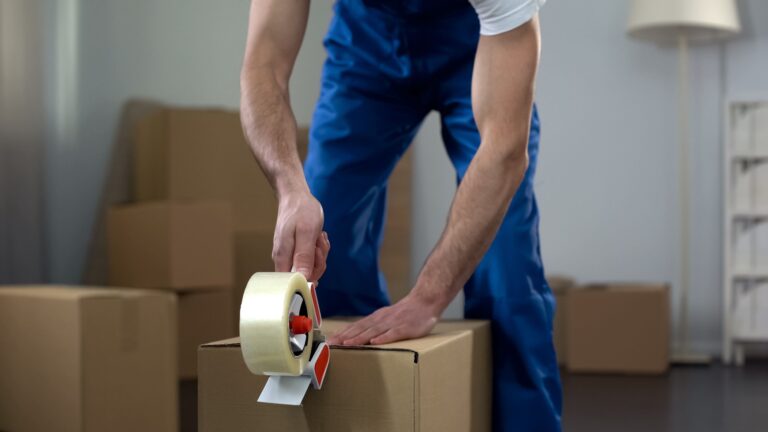Heavy Appliance Moving Guide
Heavy Appliance Moving Guide: Safe Techniques for DIY Appliance Relocation
Why Moving Appliances Wrong Costs More Than Hiring Professionals
Heavy appliances cause 60% of moving-related injuries and account for 40% of property damage during DIY moves. A refrigerator weighs 200-400 pounds, and one wrong move can damage your floors, walls, or back permanently. Learn the professional techniques that protect your body, your home, and your valuable appliances.
Essential Equipment & Safety Checklist
- Heavy-duty appliance dolly (rated for 800+ pounds)
- Furniture straps and ratchet tie-downs (minimum 4 straps)
- Moving blankets and cardboard sheets for floor protection
- Work gloves with good grip and steel-toed boots
- Measuring tape for doorways, hallways, and stairways
- At least 2-3 strong helpers (never attempt alone)
- Basic tools for disconnecting utilities and removing doors if needed
1
Preparation Phase: Disconnect & Secure (24-48 hours before)
 Refrigerator & Freezer Prep
Refrigerator & Freezer Prep
24-48 hours before: Empty completely and defrost. Clean thoroughly and let dry. Moving day: Unplug 4+ hours before moving. Secure doors with tape or straps. Remove or secure loose shelves and drawers. Keep upright—never lay flat or compressor damage may occur.
Washer & Dryer Disconnection
Washing machine: Run final wash cycle, then disconnect water supply lines. Drain completely and secure drum with shipping bolts if available. Dryer: Disconnect gas line (call professional for gas appliances) or electrical cord. Clean lint thoroughly from vent and drum.
Stove & Oven Safety
Electric ranges: Unplug or turn off circuit breaker. Remove drip pans and secure loose elements. Gas ranges: ALWAYS hire professionals for gas line disconnection—this is not a DIY job. Remove racks and burner grates for separate packing.
Never attempt alone: Heavy appliances require 2-3 people minimum. One wrong move can cause serious injury or crush limbs. Always communicate clearly with your team and establish hand signals before lifting.
2
Moving Execution: Professional Lifting Techniques (2-4 hours)
The Dolly Method (Recommended)
Step 1: Tilt appliance slightly backward while partner slides dolly underneath. Step 2: Strap appliance securely to dolly with at least 2 straps. Step 3: One person pulls dolly while another guides and supports. Step 4: Take stairs slowly, one step at a time, with spotter at bottom.
Manual Lifting Technique (Short Distances Only)
Position: One person on each side, squat with straight back. Lift: Use legs, not back—keep appliance close to body. Movement: Take small steps in unison, communicate constantly. Never: Attempt manual lifting for distances over 20 feet or up/down stairs.
Navigating Tight Spaces
Doorways: Measure first—remove doors if needed (takes 5 minutes, saves hours). Hallways: Angle appliance diagonally for wider clearance. Stairs: Use furniture sliders on bottom, one person per 100 pounds of weight, and always have a spotter.
3
Transport & Installation: Getting Appliances to Their New Home
Truck Loading Strategy
Position: Load appliances against truck’s front wall, never in middle of load. Secure: Use minimum 4 ratchet straps per appliance, attached to truck’s tie-down points. Protect: Wrap in moving blankets and pad contact points. Stand refrigerators upright—never lay flat.
Delivery Day Setup
Unloading: Reverse the loading process—use dolly and take time. Positioning: Place appliances in final location immediately—moving twice wastes energy. Settling time: Let refrigerators sit upright 4+ hours before plugging in to allow coolant to settle.
Reconnection & Testing
Utilities: Reconnect water, gas, and electrical connections carefully. Check for leaks with soapy water on gas connections. Level check: Use bubble level on washers and refrigerators—adjust feet as needed. Test run: Run a short cycle on each appliance to ensure proper operation.
Appliance-Specific Moving Tips
Refrigerators & Freezers
Always keep upright during transport. If tilted over 45 degrees, wait 24 hours before plugging in. Remove all food 48+ hours ahead. Secure water lines on models with ice makers—disconnect at shut-off valve.
Washing Machines
Install shipping bolts if available (prevents drum damage). Disconnect water lines and drain completely. Front-loaders are top-heavy when empty—use extra caution. Check manual for specific moving instructions.
Gas Appliances
NEVER attempt gas disconnection yourself—hire licensed professionals. Schedule disconnection 1-2 days before move and reconnection for delivery day. Keep gas appliances upright and well-ventilated during transport.
Appliance Moving Errors That Cause Injury & Damage

- Laying Refrigerators Flat: Compressor oil flows into cooling lines, potentially causing permanent damage. Always transport upright or call professionals.
- Rushing the Process: Taking shortcuts leads to drops, falls, and injuries. Plan 2-4 hours for appliance moving—not 30 minutes.
- Inadequate Help: Attempting with too few people or inexperienced helpers. Heavy appliances require strong, coordinated teams.
- Ignoring Manufacturer Instructions: Each appliance has specific moving requirements. Check manuals before moving—many have crucial transport guidelines.
- DIY Gas Line Work: Gas disconnection requires licensed professionals. A small leak can cause explosions—never risk it to save $100-200.
When to Call Professional Appliance Movers
- Any gas appliance requiring disconnection/reconnection
- Appliances over 300 pounds or requiring 3+ people
- Moving up/down stairs without proper equipment
- High-value appliances (wine fridges, commercial equipment)
- Tight spaces requiring appliance disassembly
- When you lack proper equipment or experienced helpers
- Insurance coverage requirements for valuable appliances
Professional appliance moving: $150-400 per appliance vs. potential damage costs of $800-2,000+. Factor in injury risk, time investment (4-6 hours), and equipment rental ($75-150). Often professionals are the smart financial choice.
Protect Your Investment and Your Safety
Heavy appliances represent thousands of dollars in value and can cause serious injury if moved incorrectly. Whether you DIY or hire professionals, understanding proper techniques protects your investment.
Remember: no appliance is worth a back injury or property damage. When in doubt, call the professionals—it’s often cheaper than dealing with the consequences of mistakes.
Plan ahead, use proper equipment, and never rush the process. Your safety and your appliances depend on it!

